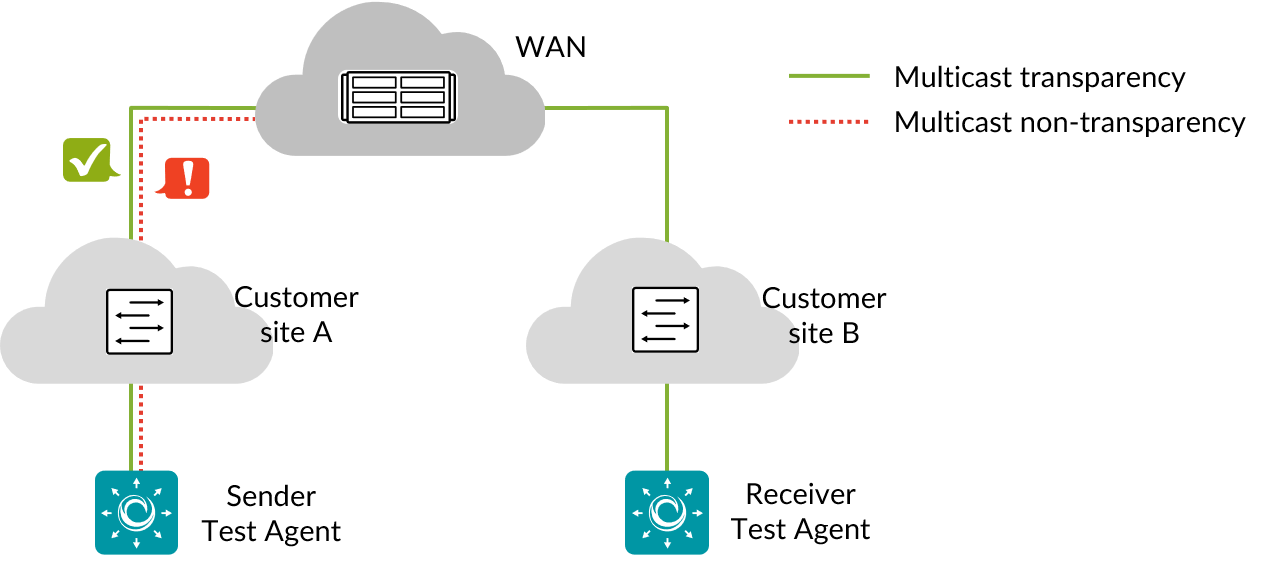L2 transparency – Multicast¶

This task verifies transparency for Layer 2 multicast protocols, i.e. checks that the multicast packets are not dropped in the network. The tested protocols are: Spanning Test Protocol, a set of general multicast/broadcast protocols, and MPLS multicast.
Test procedure¶
Five Ethernet frames with dummy payload are sent on each protocol.
For each protocol, the outcome is compared to the expected outcome (Pass or Drop) set for it.
Fail criteria¶
If the expected outcome for a protocol is set to Pass, the test fails for that protocol if less than four frames are received with the specified Ethertype and destination MAC.
If the expected outcome for a protocol is set to Drop, the test fails for that protocol if at least one frame is received with the specified Ethertype and destination MAC.
Exception: For MPLS multicast, the receiver does not check the destination MAC address; it filters only for the source MAC address and Ethertype.
Protocols tested¶
Protocol |
Destination MAC |
Ethertype |
|---|---|---|
STP |
01:80:c2:00:00:00 |
LLC/SNAP |
ARP |
ff:ff:ff:ff:ff:ff |
0×0806 |
RARP |
ff:ff:ff:ff:ff:ff |
0×8035 |
LLDP |
01:80:c2:00:00:0e |
0×88cc |
Ethernet Configuration Test Protocol |
cf:00:00:00:00:00 |
0×9000 |
IP global broadcast |
ff:ff:ff:ff:ff:ff |
0×0800 |
IP local broadcast |
ff:ff:ff:ff:ff:ff |
0×0800 |
MPLS multicast addresses |
01:00:5e:80:00:01 |
0×8848 (see Note 1) |
MPLS multicast addresses |
01:00:5e:8d:dd:dd |
0×8848 |
MPLS multicast addresses |
01:00:5e:8f:ff:01 |
0×8848 |
Note 1: Ethertype 0×8848, formerly known as the “MPLS multicast codepoint”, is to be used only when an MPLS packet whose top label is upstream-assigned is carried in a multicast Ethernet frame.
Note 2: Ethernet frames with a value of 1 in the least significant bit of the first octet of the destination address are treated as multicast frames and are typically flooded to all points on the network. While frames with ones in all bits of the destination address (ff:ff:ff:ff:ff:ff) are sometimes referred to as broadcasts, Ethernet network equipment generally does not distinguish between multicast and broadcast frames.
Limitations¶
This test can only run on physical or VLAN interfaces (not bridges).
Regarding use of the Test Agent management interface for this test, see here.
Parameters¶
General¶
Sender: The sender Test Agent interface.
Receiver: The receiver Test Agent interface.
Wait for ready: Time to wait before starting this test step. The purpose of inserting a wait is to allow all Test Agents time to come online and acquire good time sync. Min: 1 min. Max: 24 hours. Default: “Don’t wait”, i.e. zero wait time.
Advanced¶
Expected outcome for <protocol>: For each protocol, select Pass, Drop, or Don’t test. Default: Pass.
Result metrics¶
Pass/fail on STP
Pass/fail on General multicast/broadcast protocols
Pass/fail on MPLS multicast